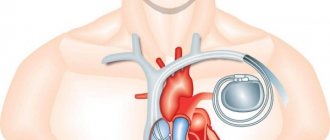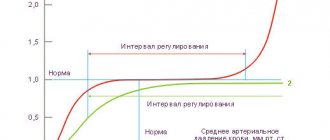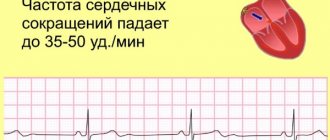In order not to harm the heart and blood vessels during sports, you need to carefully choose the type of training and increase the load gradually. This will allow your body to get used to changes in everyday life.
According to the recommendations of the World Health Organization, even if a person cannot play sports due to illness (for example, he has been diagnosed with cardiovascular, hormonal or other pathologies), one should try to include physical activity in one’s life and slowly increase the number of different exercises - this is much more better for the cardiovascular system than a sedentary lifestyle.
How do you know if your body is ready for physical activity?
To find out if the body is ready for exercise, people with health problems should consult a doctor. Any physical activity requires the right approach, systematicity and understanding of the state of your own body in order to control the load.
If a person is physically or emotionally exhausted, feels unwell, is overweight or has any other pathologies, improperly selected physical activity can harm and complicate the health condition.
Is Regular Slow Cardio Useless?
Just because the fat-burning zone and rapid weight loss are not related does not mean that cardio is useless.
First, it's a safe way to burn in a few extra calories without restricting your food intake too strictly.
Secondly, it is a way to actively recover after strength training (on a separate day). Blood circulation in the body improves, more nutrients enter the muscles and waste products are removed from them faster.
Thirdly, it is control over overtraining. If you do a lot of strength training, additional high-intensity cardio (intervals, etc.) is not a good idea for your muscles, joints, or central nervous system.
Fourth, if you have heart disease and your doctor has told you not to exercise intensely, monitoring your heart rate during exercise is a good way to stay in a heart-safe zone.
Fifth, physical fitness dictates the intensity of the workout. If you are overweight or have joint problems, only low-intensity cardio is recommended for you.
Should you have a heart test before you start exercising?
Before you start training, it is worth doing a heart examination in several cases:
- in the presence of cardiovascular diseases. It is better to start training only after a thorough examination by a cardiologist. The cardiologist will determine the condition of the heart and blood vessels, select therapy and moderate exercise, which will strengthen the cardiovascular system;
- if a person is preparing for significant physical activity (marathon running, lifting heavy loads, etc.). Additional research conducted by a doctor will help determine whether excessive effort will harm the blood vessels and heart;
- when unpleasant sensations appear (chest pain, shortness of breath, rapid or “fading” pulse, dizziness). It is necessary to determine the cause of the alarming symptoms and establish a level of exercise that will be beneficial and will not lead to a worsening of the condition.
You can contact a therapist, who, depending on the results of the examination, will refer you to a neurologist, endocrinologist or cardiologist. Additional examinations may be required to help determine your health status:
- cardiogram;
- general blood analysis;
- hormone tests;
- ergospirometry - checking the condition of the heart muscle during rest and under load (necessary in case of preparation for significant sports loads).
If your heart rate is low during exercise
A low heart rate during exercise, as noted above, indicates a disruption in the functioning of the cardiovascular system. Doctors say that people who do not reach one hundred beats per minute in six minutes are at risk of developing a complex form of arrhythmia in the future, so they need to be examined.
A slow pulse is affected by blood pressure lowering medications for tachycardia, lack of thyroid hormones, and stomach ulcers. Professional athletes tend to have low heart rates due to overtraining.
You need to know your pulse during training in order to exercise effectively without harming your heart. For the calculation, the maximum value and zone of permissible increase in aerobic loads are used. The correct training plan is one that slows your resting heart rate.
Why do heart rhythm disturbances occur?
Heart rhythm disturbances can occur for various reasons, the main ones being the wrong approach to training, lack of warm-up and cool-down, and too difficult exercises. Also, the change in heart rate depends on:
- physical condition. A beginner athlete's heart rate (HR) is higher than an experienced one;
- weight. The greater the body weight, the more intense the heart works;
- bad habits. Alcohol and smoking (even passive smoking) can speed up your heart rate;
- emotional state. Elevated or depressed mood increases heart rate;
- fatigue. A short period of time after previous training can cause arrhythmia;
- air temperature in the gym;
- intensity of movements during training.
Pulse is an important marker for determining the effectiveness of training. At rest, the normal heart rate is 60 to 90 beats per minute. During physical activity, the heart rate increases - this is the body's response to the organs' needs to increase the level of oxygen in the blood. By monitoring your heart rate, you can understand when the load is insufficient and when you should reduce the intensity of your training to restore your heart rhythm.
Safe heart rate during exercise
Heart rate is an objective criterion for assessing training load during training. Using heart rate, you can regulate the intensity of your exercise.
During aerobic exercise, heart rate indicators are not informative and cannot be used to regulate strength loads in the gym.
During sports exercises
Physical activity makes the heart beat faster. As a result, the volume of pumped blood is often released into the system to supply the human muscles and organs with oxygen, so the number of shocks increases greatly.
If the body has not previously been exposed to heavy exercise, then a high heart rate during sports is considered normal. For professionals, even during training, the heart rate increases slightly, which is explained by constant cardio loads. The heart muscle gets used to it over time and copes with pumping blood without effort.
Heart rate during strength training
Strength loads are characterized by higher heart rate readings, unlike walking or running. After them, the pulse rises to ninety percent of the maximum, but this value is suitable for healthy people. When there is no preparation or a person has suffered from any illness, the heart rate cannot be increased above 85%. For example, if a person is forty-five years old, then the permissible limit is 85% of the maximum: 220 − 45 = 175, which is 149 beats per minute.
The main thing here is to wait for the pulse to recover before another approach. He should get back to ninety beats per minute. A person should not experience shortness of breath, increased heart rate or discomfort in the heart area. If the pulse has not decreased in seven minutes, then this indicates an incorrectly selected load, and it must be reduced.
Help: If you do strength exercises with a constantly high heart rate, this can disrupt the nutrition of the myocardium.
During cardio training
This category includes fitness training. In other words, your heart rate should be between 135 and 150 beats per minute. But first you need to undergo a special computer examination, which will help determine the upper and lower pulse threshold.
Help: The duration of cardio training should be from forty to fifty minutes.
Heart rate while walking
Walking is extremely beneficial for the human body. They improve well-being, lift your spirits and promote weight loss. The normal heart rate when walking is from 100 to 125 beats per minute. At rest, normal rates are from sixty to one hundred beats per minute.
Heart rate when running in women and men
Normally, the pulse of women and men is different, but besides this indicator, there are others that radically change the final value.
The normal heart rate for men can be determined using averaged data. There are several types of loads, and they all differ in maximum heart rate and training efficiency.
For a man with average physical shape:
- warm-up - from 95 to 115 beats per minute;
- walking - from 115 to 135;
- jogging - from 134 to 154.
Help: Anything higher than the presented indicators is considered excessive and has a negative effect on the human body.
Women's indicators are as follows:
- warm-up - from 97 to 117 beats/min;
- walking - from 117 to 136;
- jogging - from 136 to 155.
While cycling
With such loads, the heart rate becomes seventy percent higher than the maximum. This frequency is used to restore the body after high loads; it can be alternated with an active mode within 70–80 percent.
If classes are held within 75% of the maximum, then endurance increases and fat burning occurs. You can move into the zone with a heart rate of eighty or ninety percent of the maximum and above for no more than one minute.
Heart rate during interval training
These are aerobic exercises that differ from standard ones in that they involve alternating pace and level of stress on the body. This type of training is used by bodybuilders, as interval training helps burn fat without losing muscle mass and increases the volume of the heart, which helps bodybuilders cope with pumping a large volume of blood.
The heart rate during such training ranges from 90 to 100 percent of maximum. Of course, there are programs that assume smaller values. Here everyone chooses the program that suits them best.
What is the optimal heart rate for a beginner athlete?
The optimal heart rate for a beginning athlete is determined before starting training. An approximate formula for determining maximum heart rate is: 220 (for men) / 226 (for women) minus age = maximum heart rate (HR) during training. However, for beginner athletes, the heart rate should be 40-85% of the maximum frequency. If your heart rate is higher, it will lead to exhaustion and symptoms of overtraining:
- constant weakness and fatigue;
- lack of positive changes from training;
- heart rhythm disturbances;
- mood swings;
- lack of desire to continue playing sports.
Heart rate is not the only indicator that you need to rely on during training. It is necessary to take into account the presence of diseases, your own weight, well-being during training and physical fitness.
You can determine the intensity of exercise without using a formula. The training should be carried out with such a load that a person can maintain a short conversation. But, if you manage to have a long conversation without shortness of breath, you should increase the intensity of your classes.
For people who are just starting to exercise, it is recommended to perform exercises under the supervision of a trainer for the first two weeks. The intensity of exercise should not be too high so that the heart rate does not exceed 150 beats per minute. Subsequently, with the development of endurance, you can increase this figure to 180 blows.
15 minutes after completing the session, your heart rate should return to pre-workout levels. This will indicate that the load is selected correctly.
Pulse zone
Pulse is the rate at which the heart beats over one minute. There is also the concept of a pulse zone, which determines the range from the heart rate at rest to the maximum load on the body.
In everyday life, a person does not need to monitor his pulse zone. But for athletes this parameter is very important. The fact is that when the heart rate is in only one zone, it promotes weight loss; at high values, the endurance of the human body increases
Help: Each person has his own pulse zone, which is determined using laboratory tests.
What is a normal heart rate in children?
For each age, there are certain indicators that can be checked in pediatric cardiology in Saratov. During the appointment, the doctor listens to the heart, determines or excludes the presence of murmurs, and also counts the number of heartbeats. If necessary, an ECG or ultrasound of the heart may be prescribed. An experienced pediatric cardiologist in Saratov will draw the attention of parents to the fact that the heart rate decreases every year. If at birth 150-160 heart beats are considered normal, then by the age of 12–13 years this number is equal to 75 beats.
The pulse rate directly shows how the heart copes with its function and how efficiently it pumps blood. If there are too many contractions, the heart muscle may become fatigued and heart failure may develop.










